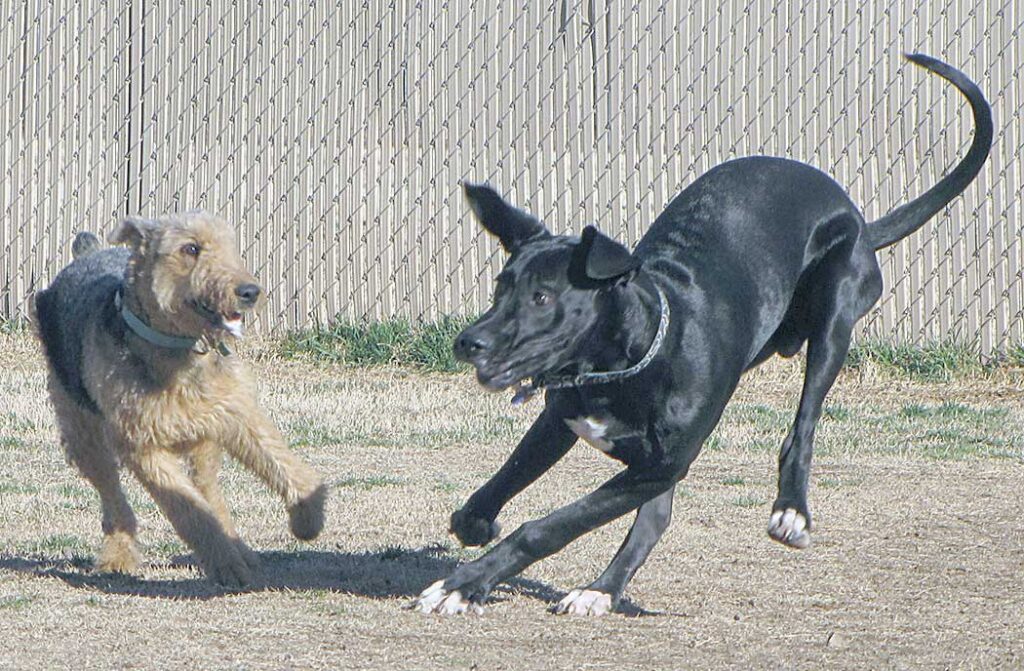By Melissa Bowersock
There are a couple places in Cottonwood that immediately come to mind when talking about dog walks.
The first is the Riverfront Dog Park, located on 10th Street, just north of Main. It’s tucked back behind some baseball diamonds and not easily noticeable, but worth the hunt. It’s 1-1/3 acres, fenced into three separate areas: the large main section, for all dogs, a smaller section for shy dogs or dogs under 25 pounds, and a third section for training or for a respite from the main run. Rules of the park are posted, and violators are reported. It’s a popular place, and it’s not unusual to find dozens of dogs there.
The main section is mostly grass (at least until heavy rain turns portions of it to mud), and there are a few trees to provide shade. There are several buckets placed around for water, a faucet with a hose for wash-offs, and a few patio chairs where you can sit and relax. People who go on a regular day or at a regular time can usually find a like-minded group to chat with.
My husband and I took our Airedale Annie there when she was young, to socialize her, and she had a ball. Not a real ball—Annie does not chase balls, although many dogs there do—but she found some besties in a Doberman named Ryker and a Great Dane named Hendrix. For two solid hours, they would run and bowl each other over, play bitey-face and only stop briefly for a head-dunking to cool off, then they’d be off again.

Annie has a habit of sticking her head into water up to her ears in order to cool off — not necessarily drinking — so I guess she goes more for the evaporative effect rather than cooling from the inside out.
Like all dog parks, there are pros and cons. The pros, of course, are the socialization, the play time, the chance to run wild and get completely exhausted (Annie would usually sleep the afternoon away after a morning at the dog park). The cons are the dogs that tend to be snippy or downright aggressive, and the owners who don’t discipline their dogs when they are out of line. I’m sure every dog park has its share.
When the dog park either becomes too wild or too crowded, there’s a quieter alternative. Just a half mile or so farther down 10th Street is the entrance to Dead Horse Ranch State Park, located along the Verde River. This used to be a working ranch, and the story goes that when the family was looking for a place to buy, there was a dead horse lying nearby.
Later when the family conferred about which property they liked best, the kids unanimously voted for the “dead horse” ranch. Thus it got its name, and when the property was sold to the state, one condition was to keep the name.
As a state park, there is an admission fee for day use or camping. The entrance fee is $7 per vehicle (1-4 Adults) or $3 per individual or bicycle. Both my husband and I volunteer at Fort Verde Historical State Park in Camp Verde, so as volunteers, we get into all state parks for free.

Dead Horse is a calm respite from whatever frazzles you or your dog. There are several ponds with trails around them. Some trails are paved, while others are dirt, but all are mainly level with only a few ups and downs unless you head out into the hills.
There are over twenty miles of trails, most shared-use for hikers, dog-walkers, bicyclists, and equestrians. Four of those trails lead up into the Coconino National Forest, while others stay closer to the Verde River.
Dogs can wade or swim in the ponds, but people also fish there, so be respectful and keep your dog from splashing around too close to the anglers and scaring the fish.
Trees abound, so there is plenty of shade. Obviously, there is water for the dogs to drink, but during the hot summer months, there can be concerns about blue-green algae, so packing water then might be a better idea. I have never heard of blue-green algae being found in the ponds, but the water is static, so better to be safe than sorry.
With all the water, trees, and heavy reeds that line some of the shores, there is an abundance of birds: redwing blackbirds, quail, great blue herons, ducks, and other water birds. Desert cottontails and jack rabbits can be found anywhere, but park visitors may also see shyer denizens: javalina, fox, deer, and even river otters. The best way to keep dogs from haring off after any of these tantalizing targets is, of course, to keep them leashed. You might, however, consider a long leash (15’-18’) to give your dog the latitude to go swimming or wading.
While there are many more outlying, more rugged areas around Cottonwood (Cherry Creek Road, Sycamore Canyon, Mingus Mountain, etc.) these two in-town areas are by far the easiest to access and require the least preparation. Whether you want abundant exercise for your dog or a quiet interlude, Cottonwood has all the options.

